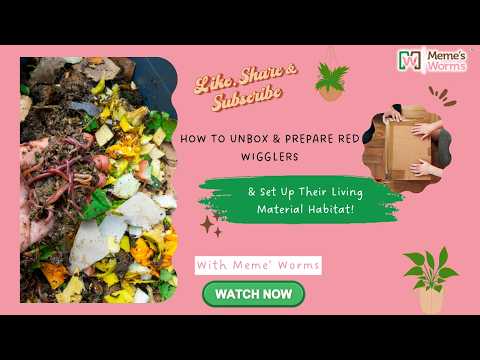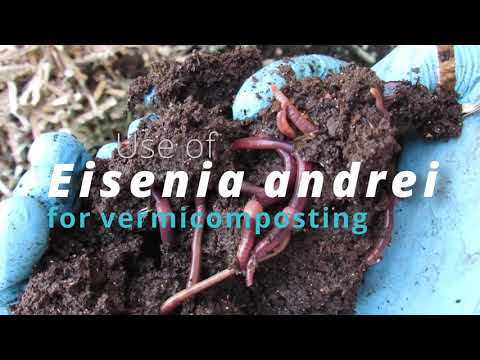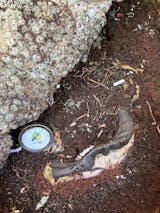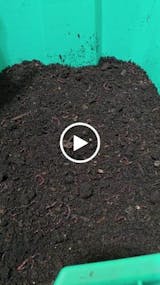


Living Material + Red Wiggler Composting Worms Eisenia andrei
Free shipping
JOIN THE SQUAD RECIEVE 50% OFF!
What to expect when buying Red Wigglers in Living Material. You will recieve a box 10x8x6 of worms, castings and living material (some cocoons too) in living material.
Note: These composting worms are small but mighty and healthy! Given time they will grow!
To protect the health and ensure the survival of the worms during delivery, Meme's Worms ships all live worm orders via USPS Priority Mail. This method follows industry best practices for transporting live organisms, helping to reduce stress and prevent losses in transit. 100 % Live Guarantee
🌟 Join Meme’s Worm Squad for FREE! and unlock 50% OFF your order of Red Wigglers with Living Material! Grab your exclusive squad member DISCOUNT now!
Join Meme’s Worm Squad, the ultimate community for worm farming enthusiasts at every stage! Whether you’re just starting out or running a successful vermiculture business, our vibrant community is here to support, connect, and help you grow! As a member of Meme’s Worm Squad, you’ll gain access to expert advice, live calls, and a network of like-minded individuals who are just as passionate about worm farming and sustainability as you are. This is the perfect place to enhance your worm farming journey. Introduce yourself, share your experiences, and get the support you need every step of the way.
⭐ Buying worms in living material rather than by the pound can be better for several reasons:
■ Health and Vitality of Worms
Worms purchased in living material, such as compost or soil, are more likely to be healthy and active. The living material provides a natural habitat that helps maintain the worms' moisture and temperature, reducing stress during transportation and ensuring they arrive in better condition.
■ Natural Environment
Living material contains microorganisms and nutrients that are beneficial for the worms. This environment supports their digestive processes and overall health, making them more effective in composting or other tasks immediately upon introduction to their new environment.
■ Reduced Mortality Rate
Worms purchased by the pound often experience higher mortality rates due to handling, dehydration, and temperature fluctuations. Living material helps mitigate these factors, providing a more stable and protective environment.
■ Immediate Integration
When worms are introduced with their familiar living material, they adapt more quickly to their new surroundings. This reduces the acclimation period and enhances their productivity in composting or soil aeration tasks.
■ Ecosystem Preservation
The living material contains not only worms but also other beneficial organisms that contribute to a healthy and balanced ecosystem. This can improve the overall health of your compost or garden soil.
■ Easier Application
Living material can be easier to spread and incorporate into compost bins, garden beds, or vermiculture systems, ensuring an even distribution of worms and associated microorganisms.
Overall, purchasing worms in living material ensures their well-being and effectiveness, leading to better outcomes for your composting or gardening efforts.
⭐ What is Living Material?
In the worm industry, "living material" refers to live organisms and their necessary habitat components that are shipped together to ensure the survival and functionality of the worms upon arrival.
This typically includes:
■ Live Worms
The primary component, such as Red Wiggler worms, which are intended for composting, gardening, or fishing.
■ Bedding Material
Organic material such as aged compost that provides a comfortable and familiar environment for the worms during transit.
■ Moisture
Adequate moisture levels are maintained within the bedding material to keep the worms hydrated and comfortable, preventing them from drying out or becoming too stressed.
■ Microbial Life
Beneficial microbes that are naturally present in the worms' habitat, which aid in the decomposition process and help maintain a balanced ecosystem.
■ Nutrient Source
Sometimes a small amount of food is included to sustain the worms during transit, especially for longer shipping durations.
By shipping these components together, the goal is to create a stable and supportive microenvironment that maximizes the chances of the worms arriving healthy and ready to thrive in their new home.
⭐ Why Choose Our Red Wiggler Worms?
■ Healthy and Vibrant
Our worms are raised in optimal conditions, ensuring they arrive at your doorstep healthy, active, and ready to get to work.
■ Eco-Friendly
Red Wigglers are nature’s perfect recyclers, turning kitchen scraps and yard waste into rich, organic compost.
Versatile Uses: Ideal for composting, gardening, and even as bait for fishing enthusiasts.
■ Sustainably Raised
We prioritize sustainable practices in worm farming, ensuring a minimal environmental footprint.
⭐ Benefits of Red Wiggler Worms
■ Efficient Composting
Red Wigglers can consume up to half their weight in organic material each day, rapidly breaking down food scraps and yard waste.
■ Nutrient-Rich Castings
The compost produced by Red Wigglers is rich in essential nutrients, enhancing soil fertility and promoting plant growth.
■ Improved Soil Structure
Worm castings help improve soil aeration and water retention, creating a healthier environment for plants.
■ Natural Pest Control
The beneficial microbes in worm castings can help suppress soil-borne diseases and pests.
The primary difference between *Eisenia fetida* and *Eisenia andrei* lies in their physical characteristics and habitat preferences. Both species are commonly used for composting due to their efficiency in breaking down organic material. Here's a detailed comparison:
⭐ The Different Types of Red Wiggers
🪱 *Eisenia fetida* (Red Tiger Wiggler)🪱
■ Physical Characteristics: Typically have alternating yellow and red bands, giving them a striped appearance. They may have a more distinct yellowish tail.
■ Habitat: Commonly found in decaying vegetation, manure, and compost heaps. They thrive in a wide range of temperatures but prefer moderate to cool environments.
■ Reproduction: High reproduction rate, making them highly effective for composting.
■ Tolerance: They are more tolerant of variations in environmental conditions, including moisture and temperature changes.
🪱 *Eisenia andrei* (Red Worm)🪱
■ Physical Characteristics: Generally more uniformly red and lack the distinct yellow bands seen in *Eisenia fetida*. They can have a darker red color.
■Habitat: Also found in similar environments as *Eisenia fetida* but may have slightly different preferences for moisture and temperature.
■ Reproduction: Slightly higher reproduction rate, making them effective for composting as well.
■ Tolerance: They might be slightly less tolerant of extreme environmental changes compared to *Eisenia fetida*, but still quite adaptable.
Composting Efficiency
Both species are excellent for vermicomposting due to their ability to consume large amounts of organic material and reproduce rapidly. They help in producing high-quality compost rich in nutrients.
Practical Use
Selection: The choice between the two often comes down to availability and specific composting conditions.
Co-habitation
They can coexist in the same compost bin, contributing to efficient composting processes.
In summary, while both *Eisenia fetida* and *Eisenia andrei* are effective composting worms with similar behaviors, they can be distinguished by their physical appearance and slight differences in environmental tolerances.
Living Material + Red Wiggler Composting Worms Eisenia andrei
How fast will my worms ship?
We ship our worms every Monday and Tuesday via USPS Priority. Once your order has been shipped it will arrive to you within 2-3 days.
I live outside of Georgia, will my worms arrive alive?
Yes! We guarantee a live delivery. Our worms are packed in breathable bags and shipped in corrugated cardboard shipping boxes. Once your order has shipped it will be at your doorstep in 2-3 days.
I won't be home to receive my worms what should I do?
You must be home to receive the worms or notify us to add a "Hold at Post Office" notice to the package.
We do not guarantee a live delivery if they are left in a mailbox or on the porch, so please let your postman know you are expecting them or follow your tracking number closely.
How many worms do I need for my compost?
You need 1 lb of worms per square foot surface area of your compost.
We guarantee that your worms will arrive alive and happy if you receive them within 2 hours of delivery. Learn more.

Frequently Asked Questions
You may also like
Worm Knowledge
What To Feed Worms in 2025: The Complete Guide
In summary, feeding worms microbial food is crucial for sustaining their nutritional needs, promoting efficient decomposition, maintaining ecosystem balance, supporting worm health, and creating op...
Worm Castings vs Worm Tea: When to Use Each for Best Garden Results
Discover the real difference between worm castings and worm tea—and why both should play a role in your garden. From nutrient-packed soil builders to microbe-rich brews for plant revival, this guid...
Vermicomposting vs Traditional Composting: Benefits and Differences
Composting has been around for centuries. Farmers, gardeners, and pretty much anyone who’s had to deal with food scraps or yard waste have relied on it as nature’s way of recycling. In recent year...







